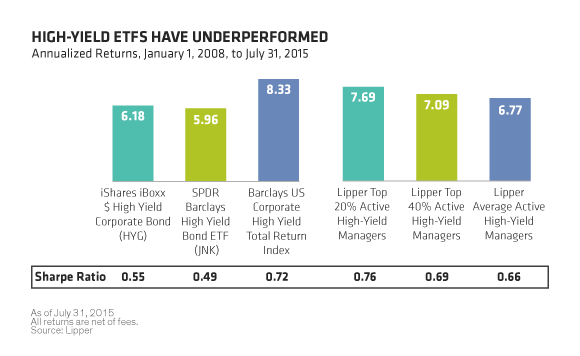Investors have been rushing into high-yield exchange-traded funds (ETFs) for years. But have they been getting their money’s worth? A look at the performance numbers offers a clear answer,“No.”
Since the start of 2013, investors have poured $8.8 billion into high-yield ETFs, according to Bloomberg data. That’s a significant amount of money, especially considering that the cash high-yield market saw some sizable outflows over the same period.
Financial advisors who use ETFs in their clients’ portfolios often tell us they like them because they passively track an index, which in theory keeps costs down, and are highly liquid.
But here’s the problem: ETFs have done a poor job of tracking those indices and have steadily underperformed actively managed funds—and they’ve been more volatile. Since the start of 2008, shortly after their inception, the two largest ETFs—HYG and JNK—delivered annualized returns of 6.2% and 6.0%, respectively, well short of the 8.3% annualized return for the Barclays US Corporate High-Yield Index.
The top 20% of active high-yield mangers, as rated by Lipper, have also comfortably outperformed these two ETFs. In fact, even the average manager has outpaced them (Display). What’s more, they’ve done it with lower volatility, as measured by risk-adjusted returns. The Sharpe ratio, which measures return per unit of risk, was 0.55 for HYG and 0.49 for JNK. But it climbed to 0.72 for the broad index and 0.76 for the top 20th percentile managers.

From both an absolute return and a risk-versus-return perspective, the verdict is clear: high-yield ETFs are a bad long-term investment.
Expenses Can Add Up
So what’s going on here?
To start with, high-yield ETFs aren’t as cheap as many investors assume. Some ETF management fees are lower than mutual fund fees, but that mostly goes for those that invest in highly liquid assets such as equities.
In a less liquid market like high yield, expense ratios are often not that different from those charged by actively managed funds. For example, HYG has an expense ratio of 0.5%. JNK’s is 0.4%. Those fees can be quite a drag on performance and often make it hard for ETFs to beat broad market benchmarks.
As we’ve noted before, there are plenty of other transaction costs associated with high-yield ETFs that can cut into returns. For instance, ratings upgrades and downgrades mean that bonds go into and out of high-yield benchmarks often—certainly more often than stocks enter and exit the S&P 500 Index. To keep up, ETF managers have to trade the bonds that make up the index more often, often at significant cost.
The costs don’t stop there. Anyone who wants to buy an ETF also has to pay a bid-ask spread, the difference between the highest price that buyers are willing to offer and the lowest that sellers are willing to sell. When volatility rises, these spreads usually widen across the board, further detracting from returns.
Passive Approach Limits Flexibility
Being tethered to an index also means that ETFs can’t pick and choose their exposures the way active managers can. That can be a problem when large swaths of the high-yield market come under pressure. Investors got a taste of this when energy prices began falling last year.
Energy companies, thanks to a multiyear borrowing binge, accounted for a sizable share of high-yield indices—about 15% of the Barclays US Corporate High Yield Index—and their bonds were hit hard as commodity prices fell.
Because they passively track an index, ETFs were heavily exposed to this sector. While active managers could have strategically reduced their energy exposure, ETF investors didn’t have that option. Those who wanted to stay invested had to accept exposure to the whole index.
ETFs Can Be Useful—But Not For Long-Term Investors
Don’t get us wrong: ETFs can be useful instruments in some instances and for some investors. Because they trade on exchanges and, like stocks, can be bought or sold at any time, ETFs can be a convenient way for short-term traders to access the high-yield market.
They can also make for effective hedging tools. For instance, investors who want to protect themselves against a sudden decline in equities might use ETFs to short high-yield debt, which is normally correlated with stocks.
But for investors looking for longer-term exposure to the high-yield market, ETFs are a poor choice. Choosing a skilled active manger affords investors a much better chance of achieving higher returns with less risk.
The views expressed herein do not constitute research, investment advice or trade recommendations and do not necessarily represent the views of all AB portfolio-management teams.